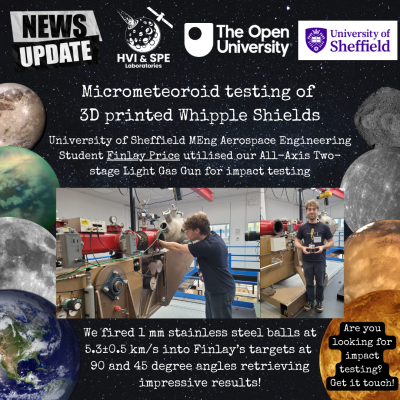3D printed Whipple Shields tested with Hypervelocity Impact!

In April, we welcomed University of Sheffield MEng student Finlay Price to the HVI lab to test some new 3D printed whipple shield designs. Using our All-Axis Two-Stage Light Gas Gun we simulated Micrometeoroid and Space Debris impacts by firing 1 mm stainless steel balls at ~5.3 km/s. The experiments yielded some excellent results for their resilience against impact! ☄️ 🛰️
Here is what Finlay said about his project:
"As I approach the end of my time at university, I've been reflecting on some of the most rewarding parts of my degree. One that stands out is my final year project, titled "Design, Prototyping and Testing of Advanced MMOD Shielding for Spacecraft: A Comprehensive Approach to Impact Resistance".
Space debris is an increasingly dangerous issue for future spacecraft operations. My dissertation tackled this challenge by exploring the use of advanced additive manufacturing to develop novel shielding solutions to protect against hypervelocity MMOD (Micro Meteoroid and Orbital Debris) impacts.
I focussed on creating lightweight alternatives to traditional Whipple shield designs by utilising TPMS-based structures, including periodic Gyroid and Diamond TPMS unit cells. Simulated impacts were run using LS-DYNA, where a 1mm diameter stainless steel sphere was launched at each design at 5 km/s. The shields, each weighing around 50 grams, were fabricated at the Royce Discovery Centre with support from the Royce at the University of Sheffield. Final testing was conducted at the OU-HVI-SPE-Labs, where speeds of up to 5.6 km/s were achieved. Both designs successfully prevented penetration of the rear wall, achieving their goal of protecting critical spacecraft components.
This hands-on experience has been the biggest highlight of my time at The University of Sheffield and has furthered my interest in using additive manufacturing for spacecraft protection.
Many thanks to Iain Todd FREng and Rob Snell for their invaluable supervision and support throughout my project. Thanks also to Royce at the University of Sheffield and OU-HVI-SPE-Labs for providing access to their facilities, especially Zoe Emerland for assisting with testing and the lab tour. Finally, thank you to Space Forge for sparking the idea behind this research.
This project has not only deepened my understanding of hypervelocity impacts but also reinforced how critical innovative materials and manufacturing methods are in tackling the future of space sustainability."